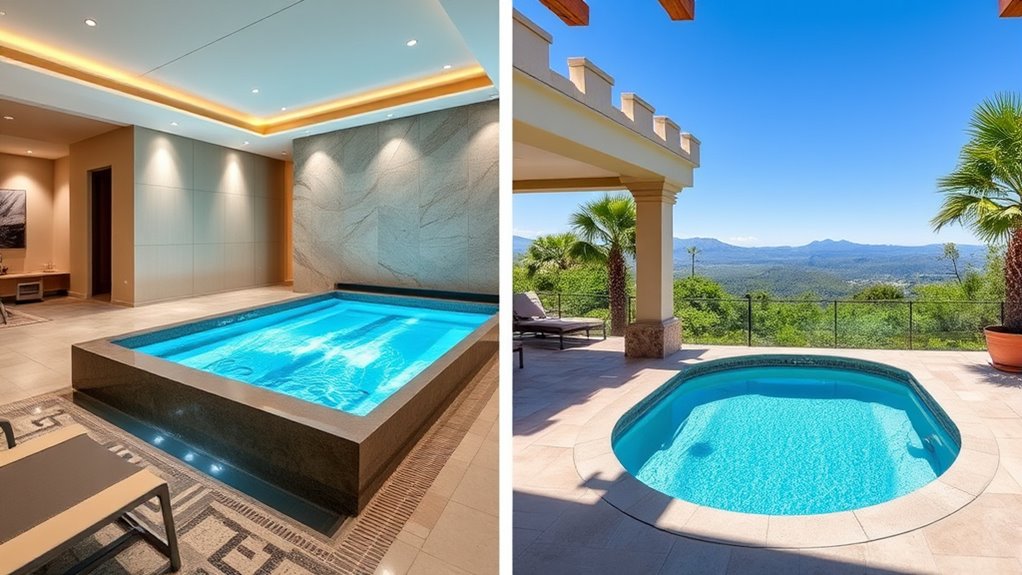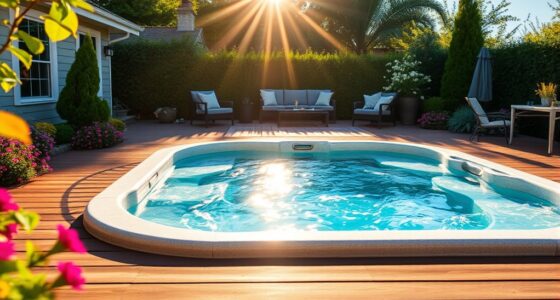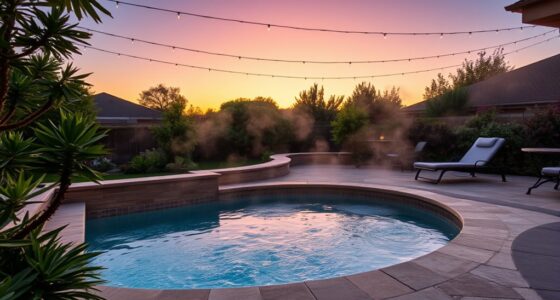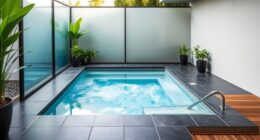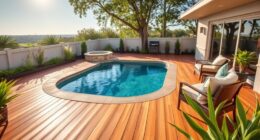When choosing between indoor or outdoor swim spa installation, consider how climate, insulation, and electrical setup impact your experience. Indoor spas offer better temperature control and protection from weather, but require proper ventilation and insulation. Outdoor models are easier to install and weather-resistant but face temperature fluctuations and more outdoor maintenance. Both options involve specific electrical and environmental considerations. To make certain your setup matches your needs and saves you money, it’s helpful to explore these factors more deeply.
Key Takeaways
- Indoor swim spas require proper insulation and ventilation to manage humidity and prevent mold, unlike outdoor models designed for weather resistance.
- Outdoor spas generally need less complex electrical wiring but require weatherproofing and robust heating systems for temperature stability.
- Indoor installation offers better climate control, reducing energy costs, while outdoor spas face weather fluctuations that increase heating and maintenance needs.
- Space, ventilation, and structural support are critical factors for indoor setups, whereas outdoor spas demand considerations for protection against elements.
- Both options should be planned with energy efficiency in mind, balancing insulation, electrical requirements, and environmental factors for optimal operation.

Thinking about installing a swim spa? One of the most important factors to evaluate is where you’ll place it—indoors or outdoors. Your choice will influence many aspects of installation, especially water temperature management and electrical requirements. If you’re leaning toward an indoor setup, you’ll need to think about how the space will handle the water’s temperature. Indoor swim spas often require additional insulation or climate control to maintain consistent water temperature, especially during colder months. Without proper insulation, your spa’s heating system will work harder, increasing energy costs and possibly straining the electrical system. It’s vital to assess the room’s size, ventilation, and humidity control to prevent issues like mold or corrosion.
Indoor swim spas require insulation and climate control to maintain temperature and prevent issues like mold.
When it comes to electrical requirements, indoor installations tend to need more planning. Your space must have adequate electrical wiring to support the spa’s heater, pump, and lighting systems. Many indoor swim spas demand a dedicated electrical circuit to ensure safety and compliance with local codes. You might also need to upgrade your existing electrical panel or install a dedicated GFCI outlet to handle the load safely. Failing to meet these requirements can lead to electrical hazards or frequent system malfunctions. Consulting a licensed electrician before installation is a smart move, so you’re sure everything is up to code and your system can handle the load.
On the other hand, outdoor swim spas usually offer more straightforward electrical requirements. Since they’re designed to withstand the elements, many models come with built-in insulation and weather-resistant features. Their placement often simplifies the electrical setup, typically requiring a standard outdoor GFCI outlet and minimal wiring, especially if you opt for models with pre-wired systems. However, outdoor installations still demand careful planning. You’ll need to account for power supply distance, weatherproofing, and possibly installing a dedicated circuit to prevent overloads, especially if you plan to run multiple features like jets and lighting.
Water temperature control is another critical point. Outdoors, fluctuating weather conditions can make maintaining a consistent water temperature more challenging. You’ll likely need a reliable heating system with sufficient capacity and good insulation to keep the water at your desired temperature, regardless of outdoor climate changes. Indoors, temperature stability is usually easier to manage because the environment is more controlled. This means your heater doesn’t need to work as hard, which can save energy and prolong the lifespan of your equipment.
Ultimately, your decision should weigh these factors carefully. Think about your climate, space, electrical infrastructure, and how much control you want over water temperature. Both indoor and outdoor swim spas have their advantages, but understanding their specific electrical requirements and how they influence water temperature management will help you make an informed choice that fits your lifestyle and budget.
Frequently Asked Questions
What Are the Energy Costs Differences Between Indoor and Outdoor Swim Spas?
When comparing energy costs, indoor swim spas typically have higher energy consumption than outdoor ones due to insulation challenges and maintaining a consistent temperature inside. You’ll likely see a higher cost comparison for indoor setups, especially in colder climates. Outdoor swim spas generally use less energy because they benefit from ambient temperatures. Still, factors like insulation, climate, and usage frequency influence overall energy costs for both options.
How Does Climate Impact Maintenance for Indoor Versus Outdoor Swim Spas?
Climate greatly affects maintenance for your swim spa. If outdoors, you need to focus on humidity control to prevent mold and corrosion, especially in humid areas. Pest prevention becomes essential to keep insects and animals out of the spa. Indoors, you face less weather-related debris, but you should still monitor humidity levels to avoid mold growth. Proper ventilation and regular cleaning help reduce these issues, ensuring your swim spa stays in top condition.
Are There Specific Building Codes for Indoor Swim Spa Installation?
Did you know that roughly 70% of indoor pool installations require specific building permits? When installing an indoor swim spa, you must check local building codes to guarantee compliance. These codes often specify requirements for structural support and ventilation systems. You should consult with local authorities to confirm if you need permits or inspections, and ensure your space can support the weight and infrastructure necessary for a safe and compliant installation.
What Are the Ventilation Needs for Indoor Swim Spas?
You need to meet ventilation requirements to guarantee good indoor air quality when installing a swim spa indoors. Proper ventilation helps control humidity, prevent mold growth, and remove chemical fumes from sanitizers. You should install an adequate exhaust system, like an exhaust fan or air exchange system, to maintain fresh air circulation. This not only protects your health but also preserves the structure of your space, making your swim spa experience safe and enjoyable.
How Does Lighting Differ Between Indoor and Outdoor Swim Spa Setups?
Lighting in your swim spa setup acts like a painter’s brush, shaping the ambiance. Indoor setups rely on thoughtful lighting design, with fixtures that mimic natural light to create a welcoming glow. Outdoor setups bask in the sun’s natural light, transforming your spa into a shimmering oasis. You control the mood with artificial lights indoors, while outdoors, the sun’s natural radiance often takes center stage, blending beauty and function seamlessly.
Conclusion
Ultimately, whether you opt for an indoor or outdoor swim spa, prioritize practicality and passion. Proper planning prevents problems, so consider space, safety, and seasonal shifts. By balancing basic needs with bold ambitions, you’ll build a beautiful, blissful backyard or basement retreat. Remember, thoughtful timing and tailored tactics make your swim spa installation smooth and satisfying. Stay savvy, stay safe, and start splashing — success is just a decision away!
